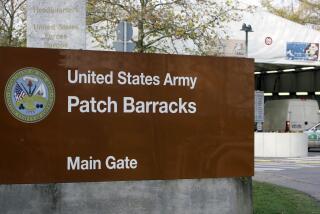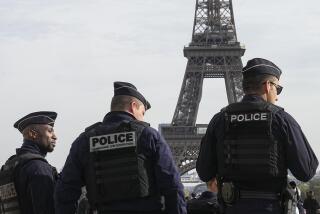Terrorism Alert Level Is Lowered a Notch at 5 Financial Institutions
- Share via
WASHINGTON — The government on Wednesday lowered the terror alert level for five high-visibility financial institutions here and in New York and Newark, N.J., citing improved protective measures at the buildings.
The institutions affected are the World Bank and the International Monetary Fund, both a few blocks from the White House; the New York Stock Exchange and the Citigroup Center in New York; and the headquarters of Prudential Financial Inc. in Newark. Computer files seized in Pakistan this summer had identified the facilities as being under surveillance by Al Qaeda.
The action Wednesday amounted to a fine-tuning of the nation’s civil defense safeguards, officials said. It returned the alert level for the financial institutions to “yellow,” or an elevated risk of attack, the midpoint on the government’s five-point color-coded scale. It had been raised for those locations on Aug. 1 to “orange,” indicating a high probability of an attack.
Since the color-coded scale was introduced in March 2002, the terror threat level nationwide has been raised to orange and lowered to yellow five times, although New York has continuously maintained an orange-alert status. The action this summer was the first time the threat level had been changed for individual buildings.
Deputy Homeland Security Secretary James M. Loy said Wednesday that the decision to lower the threat level had nothing to do with President Bush’s victory in last week’s presidential election.
“We don’t do politics here at this department,” he said. “The hardening of the buildings that has occurred has now been accomplished. We are able to do this now.”
As early as the spring, senior officials in the Department of Homeland Security had warned that attacks could come during the election season, although they noted that intelligence agencies had received no specific threats. That prompted some Democrats to complain that such vague warnings could intimidate voters.
Loy said security agencies would remain on full alert through the Jan. 20 presidential inaugural. “The whole notion of taking a deep breath and saying, ‘Wow, we got past this and now it’s OK for a while’ is a very dangerous train of thought,” he said.
Alarms were raised about the financial centers after the arrest of an Al Qaeda operative in Pakistan led to the discovery of the computer files. They included surveillance reports on the facilities that suggested planning for a car- or truck-bomb attack. Intelligence officials said at the time that the files were not dormant, but had been recently accessed by members of the terrorist network.
Loy said it now appeared that the surveillance did not develop into a plan to actually attack.
“We never saw anything that suggested a transition from casing the places to building an action plan,” he said.
Each facility has taken steps to deter an attack and to contain damage if one should occur, said Loy, declining to list the measures.
Some are evident to passersby. Concrete barriers have been placed on sidewalks around the World Bank to prevent a vehicle, perhaps loaded with explosives, from crashing into the building. Metered parking spaces on the street have been eliminated, and more police and security guards are on patrol.
Loy said the financial sector as a whole took note of the alert to strengthen emergency preparedness and improve communication links with the government and key private institutions.
More to Read
Sign up for Essential California
The most important California stories and recommendations in your inbox every morning.
You may occasionally receive promotional content from the Los Angeles Times.













